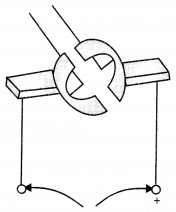Electric Generator
An electric generator works on the principle of electromagnetic induction. When an armature is rotated in a magnetic field, an electric current is induced in the coil. Here, mechanical energy is used to rotate a conductor in a magnetic field to produce electricity which is based on the phenomenon of electromagnetic induction.
Components of Electric Generator
Armature: It contains coiLs of wire of many turns.
Rings: These are of two types:- Solid ring, used in A.C. generator and split ring, used in D.C. generator.
When a solid ring is used, as the coil rotates, the direction of induced currents in both the segments change, i.e., the polarity of the current changes in the respective arms after every half a rotation.
When a split-ring is used, one brush is at all times in contact with the wire moving up in the field due to which unidirectional or direct current is produced.

Split-ring commutator for a DC generator
The difference between Direct current and Alternating Current Direct current is unidirectional, that is, it always flows in one direction. The alternating current reverses its direction periodically. Power can be transmitted over long distances using AC without much loss of energy.
Example 1.
Explain different ways to induce current in a coil.
Answer:
Different ways to induce current in a coil are:
- Relative motion between a coil and a magnet either by moving a coil near a stationary magnet or moving a magnet near a stationary coil.
- By changing the current flowing through a coil.
Example 2.
Choose the correct option.
A rectangular coil of copper wire is rotated in a magnetic field. The direction of the induced current changes once in each
(a) two revolutions
(b) one revolution
(c) half revolution
(d) one-fourth revolution
Answer:
(c) half revolution
Explanation: The direction of motion of coil changes after every half revolution thereby changing the direction of induced current also.